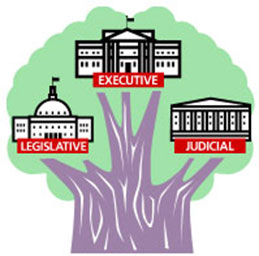The Framers of the U.S. Constitution wrote the document to insure that Americans were free from the tyrannical bonds that once tied them to Great Britain and from future tyrannical control. They wanted to avoid the mistakes made by the Articles of Confederation; the Framers wanted to be sure that the functions of the three branches of government were clear. Most importantly, they wanted to be sure that one branch did not overpower another.
![]() Click on the selected Articles from the U.S. Constitution to learn more about the legislative, executive, and judicial branches of government.
Click on the selected Articles from the U.S. Constitution to learn more about the legislative, executive, and judicial branches of government.
Click here to access the entire contents of Articles I, II, III.
There are several principles of the U.S. Constitution. Read below to learn more.

| Popular Sovereignty | government is created and subject to the will of the people |
| Limited Government | government is limited to the powers that are given to it by the people |
| Separation of Powers | the system of the federal government in the United States with three separated powers: the legislative, executive, and judicial branches |
| Checks and Balances | the power for one of the three branches of government to stop or check the other two if either one or both overreach its boundaries |
| Federalism | the system of federal government where power is divided between the federal and state governments |
| Judicial Review | the judicial power to invalidate legislative or executive acts where the justices declared the acts unconstitutional |
Two of these principles will be examined in this lesson. The principle of separation of powers is the principle of separating power in the federal government into three branches: legislative, executive, and judicial. The Framers included this principle in the Constitution to avoid tyranny in government.
The Constitution does more than just separate power among three branches. Each branch's power overlaps the other two. At least two branches of government have to agree in order for the government to move forward. This feature is called checks and balances, because one branch can stop (check) another branch from acting, and the power is evened out (balances).
The Supreme Court has the biggest check of all, declaring a law unconstitutional. However, it rarely uses that power. In the day-to-day operation of the government, the legislative and executive branches most often "check" and "balance" each other.
![]() In this activity, you will find the balancing act of powers. The power of the federal government will appear. Decide whether it belongs to the legislative branch (Congress) or the executive branch (president).
In this activity, you will find the balancing act of powers. The power of the federal government will appear. Decide whether it belongs to the legislative branch (Congress) or the executive branch (president).
In this lesson, you will read about several events in U.S. history where the principles of separation of powers and checks and balances were tested. You will learn more about how these events caused a significant change in the relationship between the branches of government during that time.